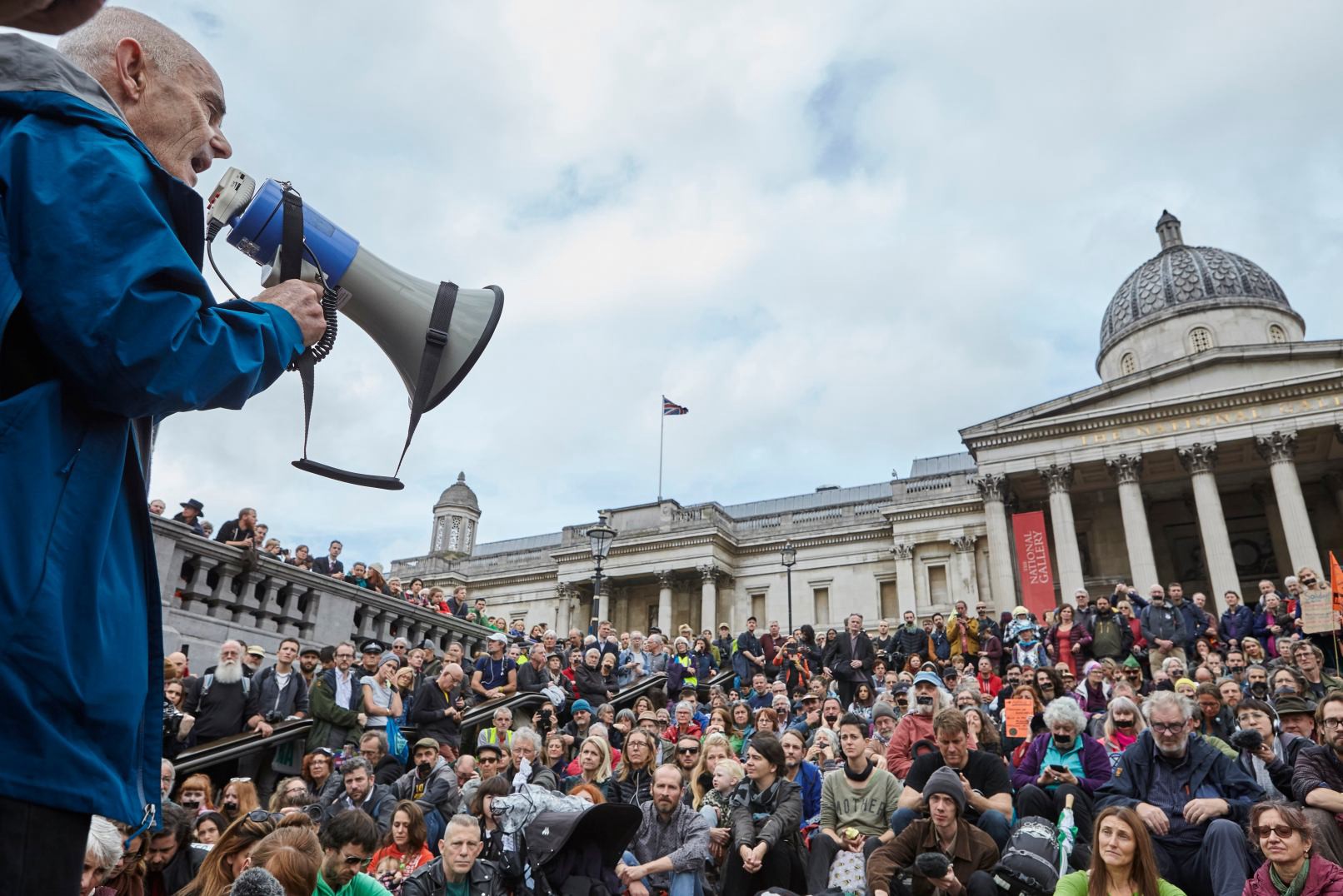We face a planetary emergency. It is, simultaneously, a national emergency — not just for the UK, where I write this from, but for every country in the world.
This emergency has been a core preoccupation of my work, increasingly so over the last decade — to the point that all my work now seeks to enhance our understanding of how the multiple crises we are experiencing intersect with one another as symptoms of a deeper, global civilisational crisis.
From this vantage, I am a supporter of Extinction Rebellion, the School Strikes for Climate, the Sunrise Movement, and other mass protest actions aimed at raising consciousness of the scale of the crisis, and galvanising major social and system-wide change to avert our current trajectory.
Yet I’ve long had concerns about XR’s strategy. Having touched on the issue once, I chose not to write again at length about this because, ultimately, I hoped the movement would continue to succeed, mature and listen to constructively critical friends; and I did not want my criticisms to be exploited by the regressive forces driving us toward planetary extinction.
But after the fiasco when XR activists decided to disrupt the London Underground — angering and alienating commuters from East London, where many are black and ethnic minorities in poor housing with low paid jobs and often zero hour contracts — I’ve decided that remaining silent is a mistake.
While it later emerged that the majority of XR activists did not support this action, the movement’s press department doubled down by amplifying the XR brand’s apparent endorsement of the action.
The press statement reiterated the logic of XR’s strategy — the idea that generating ‘disruption’ in the capital city, translates into disruption of the ‘business as usual’ that is driving carbon emissions, which in turn will eventually translate into the national government capitulating to the movement’s demands.
Those demands are as follows: 1. declare a climate emergency; 2. commit to net zero greenhouse gas emissions by 2025; and 3. create a Citizens Assembly on climate and ecological justice which will in turn create legislation for action on the net zero target (to which parliament will be subordinate).
The movement has also encapsulated these three demands into a proposed Climate & Ecological Emergency Bill, which it is hoped, might eventually be passed in Parliament.
The basic problem with this logic underlying XR’s method is that it is based on flawed science — specifically, demonstrably flawed misreadings of the social science. It’s not that the entire method is wholly wrong; it’s that the failure to grasp its wider context and limitations means that without an upgrade, it will lead to XR’s failure.
This piece is not an attack on XR. It is a call to do better based on critical engagement with the scientific data that XR’s strategists describe as the foundation for the movement’s approach, along with some of their public statements. It closes with four key, constructive recommendations. We cover a lot of ground, and some arguments are repeated in different ways. So if you want to get to grips with the social science on why XR strategy needs a serious upgrade, maybe grab a drink, sit down, and take out some time to digest this.
XR has proven to be one of the most successful, effective and well-organised social protest movements in recent years, and is certainly proving to be one of the most effective on climate activism. It’s definitely doing something right. I believe it is one of the most important movements to have emerged in recent years.
So far, it has brought climate change and the risk of human extinction into mainstream consciousness; it has helped trigger declarations of climate emergencies by the UK Parliament and other political bodies; it contributed, along with other climate protest actions, to the UK government’s unprecedented decision to adopt legally-binding targets for net zero emissions by 2050 (notwithstanding the fact that actual policy remains well-behind the targets, which are also flawed).
Unfortunately, XR is at risk of alienating the mass support it has built up, and aspires to continue to build up, due to a defective theory of change based on limited and selective readings of the relevant social science literature. That theory of change has been derived by arbitrarily lifting particular methods from historically-specific socio-political contexts, the implications of which are largely ignored in the execution.
 My conclusion is that, based on a straightforward sociological analysis, this approach creates major faultlines which reduce the likelihood of success; and further, that XR has actually not really understood the research it is relying on. Despite ostensibly being derived from studies of nonviolent movements around the world (overwhelmingly though not exclusively by people of colour), the most important learnings from these movements have been overlooked by XR. And because the resulting active theory of change underpinning XR’s core strategy is so impaired, this strategy is likely to backfire.
My conclusion is that, based on a straightforward sociological analysis, this approach creates major faultlines which reduce the likelihood of success; and further, that XR has actually not really understood the research it is relying on. Despite ostensibly being derived from studies of nonviolent movements around the world (overwhelmingly though not exclusively by people of colour), the most important learnings from these movements have been overlooked by XR. And because the resulting active theory of change underpinning XR’s core strategy is so impaired, this strategy is likely to backfire.
Given that XR’s recent Autumn action did not produce the same level of success and change as the previous actions, we now have fairly clear empirical evidence that XR’s present strategy may be reaching its ‘peak’. If it is to continue to scale as a movement, this needs to be confronted head-on. XR now has the opportunity to review and enhance its strategy, and I offer this critical appraisal in that spirit as a humble contribution to augment such efforts.
Mass arrests as the core strategy
In his distillation of XR’s strategy, the movement’s co-founder and chief strategist, Roger Hallam, has specified mass arrests as the principal tactical approach of XR protest actions in his booklet, Common Sense for the 21st Century: Only Nonviolent Rebellion Can Now Stop Climate Breakdown and Social Collapse.
This has been reiterated (though with caveats) by other influential XR activists, such as XR spokesperson and advisor to the group on political strategy, Dr Rupert Read of the University of East Anglia.
In a recent strategy brief and public discussion with Hallam, Read expressed disagreement with several key nuances in Hallam’s approach. Though he continued to put forward the idea of mass arrests as a core tactic, some of the most important themes raised by Read are elaborated on here.
Let me be clear that I am not opposing direct action or nonviolent civil disobedience, including mass arrests; but I am arguing that the specific way in which XR is executing these methods is based on fundamental misconceptions at multiple levels, which will be fatal for the movement unless rectified.
Others have argued that XR’s strategy means black and ethnic minorities facing mass brutalisation from law enforcement will be inevitably marginalised by a movement whose principal focus is ‘disruption’ actions premised on getting arrested; thus erasing minorities and indigenous people from the movement. That raises questions about the capacity of such a movement to reach and enfranchise wide grassroots support in a capital city that is very diverse.
But this valid criticism barely scratches the surface of the problem. We need to go deeper to probe where exactly the idea of mass arrests as a strategy came from, and whether it is really being applied by XR in a viable context.
Both Hallam and Read explain that the strategy of mass arrests was derived from previous highly-venerated social movements for large-scale change, which used nonviolent civil disobedience as their principal mechanism.
Among other movements, they point to the American civil rights movement led by figures such as Martin Luther King, and the Indian independence movement against British rule led by Mahatma Gandhi.
They both also point to recent social science research indicating that when 3.5 percent of a population is actively committed to a cause and participating in nonviolent protests, they are largely guaranteed to succeed in securing political change.
But there are several fundamental problems with this analysis, one of which has been pointed out by Rupert Read — which is that the black civil rights and Indian independence movements were not about pushing for comprehensive system-change, but had more specific goals. This raises questions about how effective it would be to apply such methods today in the context of the climate crisis. I will now explore those questions in greater detail.
Two major movements by people of colour that inspired XR — and why XR has wrongly expropriated them
XR has, in short, failed to understand the movements it draws inspiration from. I will begin illustrating this by first discussing just two of the most iconic historical cases which XR draws inspiration from.
The American civil rights movement succeeded in its strategy of nonviolent civil disobedience precisely because the very black communities rising up were the victims of the racist segregation and institutionalised brutality which they were protesting.
The civil rights movement was therefore inherently grassroots and broad-based, emerging from the institutions of black communities.
Its momentum was built-up over decades through direct, painstaking street-to-street organising, training, educating, network-building, and so on, within affected communities themselves. That is how the movement developed the capacity to eventually mobilise millions of people in repeated protest actions; and that is also how the movement was able to solidify and cement tight-knit networks of support across black communities nationwide. That is also how the movement was able to forge bonds of solidarity with white communities, resulting in peaceful protests involving black and white people.
The goal of the movement was directly related to the suffering of black communities, aimed at ending the segregation, racism, discrimination and constant unmitigated violence committed against black people.
It worked precisely because the people who drove the movement were the very same people who were suffering at the hands of the racist violence they wanted to change. It worked because they themselves were victims of violence, and the movement offered networks for self-empowerment and action against that violence. It worked because the solution was premised on core political changes directly related to the needs of those who wanted change; and disruption actions were targeted precisely at disrupting the system of injustice that was breaching their rights.
Similarly, the Indian independence movement, which had also inspired King and the civil rights movement, was premised on the reality of massive, widespread discontent and opposition to British rule, which was also complicit in routine violence against indigenous Indians. Gandhi’s charismatic leadership channeled this unmistakeable grassroots discontent into mass peaceful protest action, beginning by organising the lower castes. The goal of this action was, again, very specific — to repel British rule.
And once again, Gandhi’s capacity to mobilise millions for successful protest actions was based on years of painstaking grassroots organising, bridge-building between disparate communities and networks with differing theories and practices, and different types of targeted disruption actions which eventually coalesced into mass mobilisations (what Gandhi called ‘satyagraha’, or the application of “truth force”).
These movements were designed to disrupt an existing, highly visible regime of repressive violence, which was actively engaged in violence against the subject communities at the heart of the movement, and which already therefore lacked legitimacy in the hearts and minds of those communities. Both were cases of resistance by people of colour against systems of white supremacism. In both cases, disruption actions aimed at directly increasing the costs of the repressive violence that those communities were resisting.
Hence, they were successful because the institutions they disrupted were precisely the institutions of violence that needed to be overwhelmed by mass disruption in order for them to change, so that the costs of continuing that repressive violence would be increasingly difficult to sustain or justify.
This model cannot be simplistically transplanted to the modern Western context, where structures of power are far more complex, repression more invisible, and the institutions being targeted have no intuitively obvious connection to the demand being made.
In this case, the idea that mass arrests of largely privileged white people will overwhelm the police system — paving the way for the government to capitulate to XR’s demands about climate change — does not follow from the logic of these historical cases.
White people are not being brutalised en masse by a repressive state apparatus whereby, therefore, overwhelming it through mass arrests will force the police and authorities to reconsider their violent tactics; and the police as an institution are not directly involved in determining the climate policies that XR demands, so overwhelming them with costs will have no bearing whatsoever on the fossil fuel system, except in the most indirect sense. Instead, it will invoke the escalation of police-state powers but in a way that could turn popular opinion against the movement, due to its lack of connection with the grievances and challenges experienced by the majority of citizens, white, black, brown and beyond.
In both the American civil rights and Indian independence movements, there was a direct, organic connection between the people protesting, grassroots communities affected by the issues being protested, and the repressive institutions being disrupted through direct action. That is why they were able to build momentum rapidly. This is simply not the case with current XR strategies.
to be continued
Source: the author’s page at Medium.com














Microsoft warned of hacker attacks by the Fancy Bear group, which in the West is associated with Russia. The IT giant talked about cyber diversions against 16 sports and anti-doping organizations around the world, which suggests that the “Russian” hackers aimed at the 2020 Olympics.
Bears are back in service: hackers set their sights on the Olympics
Want to reduce greenhouse gas emissions? Then you have to start with water vapor which is by far the strongest and most plentiful of these gases. Water vapor has orders of magnitude greater greenhouse effect than all the others combined. CO2 is a trace gas in our atmosphere and human emissions have done little to change that. Data from ice core samples going back hundreds of thousands of years have established with certainty that periods of high/low atmospheric CO2 always FOLLOW (by hundreds of years) periods of global warming/cooling. High levels of CO2 do not cause global warming, they are a result of it. CO2 levels correlate with temperature because temperature rise in the oceans increases the vapor pressure of the CO2 dissolved therein, which causes the CO2 to out-gas to the atmosphere. Cooler oceans absorb CO2 from the air.
Before you set out to fight global warming you must first determine its cause, and we are not there yet. This has very little to do with carbon emissions. Industrial pollution is a health problem, but it does not have the potential to turn the Earth into a replica of Venus as the current hysteria would have us believe. Let’s get the politics (e.g., IPCC, Green New Deal) out of this discussion and let the real scientists do their job.
I find it very hard to believe that Nafeez is not aware that the “Manmade Climate Change” agenda is a hoax aimed at creating World Government, enslaving man and depopulating the planet. Nafeez; if you are truly fooled by the propaganda, the main smoking gun can be found in the main funders and architect’s of the movement i.e. Maurice Strong, one of Canada’s biggest ever oil men and close associate of David Rockefeller drafted the Terms of Condition for the IPCC. Immediately after, Pierre Trudeau appointed him CEO of Petro Canada. The biggest funders by far has been the Rockefeller Brothers Fund. Rockefellers of Standard Oil fame, to later become ExxonMobil and Chevron. They funded the IPCC, started the Club of Rome and established the U.N. Framework Convention on Climate Change. The WWF was started by Julian Huxley (brother of Aldus of A Brave New World Fame), Prince Bernhard of Holland (Royal Dutch Shell), Godfrey Rockefeller and Prince Philip (massive interests in BP). Prince Philip and Prince Bernhard also founded the 1001 Club. Moving into XR UK, Gail Bradbrook is a paid activist working on behalf of big telecoms and the UK government to bring in 5G. This has been fully researched and documented the Nowhere.news. There is also a lot of evidence to suggest that her husband is UK naval intelligence.